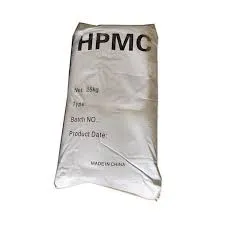
Сеп . 19, 2024 15:49 Back to list
HPMC Water Soluble - A Comprehensive Guide
HPMC, or Hydroxypropyl Methylcellulose, is a widely used polymer derived from cellulose. It is a versatile compound that finds applications in various industries, including pharmaceuticals, construction, food, and cosmetics. One of the most prominent characteristics of HPMC is its water solubility, which plays a crucial role in its functionality and usability in different formulations.
HPMC is produced through the chemical modification of cellulose, a natural polymer sourced from wood pulp or cotton. The process involves the etherification of cellulose with propylene oxide and methyl chloride, resulting in a compound that retains the structural integrity of cellulose while acquiring new properties. The degree of substitution, which refers to the number of hydroxyl groups that have been replaced with hydroxypropyl and methyl groups, influences the solubility and viscosity of HPMC in water.
.
One of the remarkable advantages of HPMC is its compatibility with a wide range of other ingredients, including active pharmaceutical ingredients (APIs) and excipients. This makes it an ideal choice for formulating drug delivery systems, such as controlled-release tablets and suspensions. The ability of HPMC to form gels in the presence of water is particularly beneficial when developing formulations that require sustained release of the drug over an extended period.
is hpmc water soluble

In the food industry, HPMC is often used as a thickener, emulsifier, and stabilizer. Its water solubility allows it to create smooth and consistent textures in various food products, including salad dressings, sauces, and baked goods. Additionally, HPMC is valued for its ability to retain moisture, which is essential for improving the shelf life and mouthfeel of food items.
In the cosmetics and personal care sector, HPMC is utilized as a film-forming agent and a thickener in products such as lotions, creams, and shampoos. Its water solubility is crucial for creating stable emulsions and providing a pleasant texture to cosmetic formulations.
The environmental impact of HPMC is another important factor to consider. Being derived from cellulose, it is biodegradable, making it a more environmentally friendly alternative compared to synthetic polymers. This characteristic appeals to eco-conscious consumers and companies looking to reduce their ecological footprint.
In conclusion, the water solubility of HPMC is a defining characteristic that significantly enhances its functionality across multiple industries. Whether it is used in pharmaceuticals, food, or cosmetics, HPMC plays a vital role in improving the quality and performance of products. Its versatility, compatibility, and environmental benefits ensure that HPMC will continue to be a valuable ingredient in a wide array of formulations for years to come.
-
Unlocking the Benefits of HPMC Products: A Gateway to Versatile Applications
NewsAug.07,2025
-
Unleashing the Potential of HPMC Ashland: A Comprehensive Look
NewsAug.07,2025
-
Tile Bonding Cellulose: The Key to Superior Adhesion and Durability
NewsAug.07,2025
-
Hydroxypropyl Methylcellulose Powder: The Versatile Component in Modern Pharmaceuticals
NewsAug.07,2025
-
Hydroxyethyl Cellulose: The Versatile Solution for Various Industries
NewsAug.07,2025
-
Hydroxyethyl Cellulose (HEC): The Versatile Polymer for Various Applications
NewsAug.07,2025







